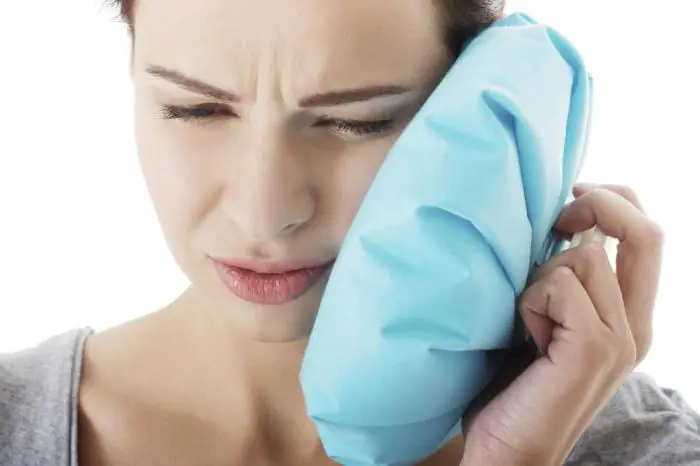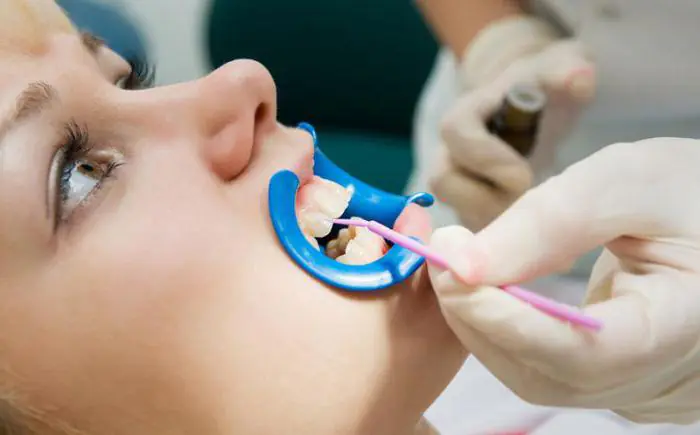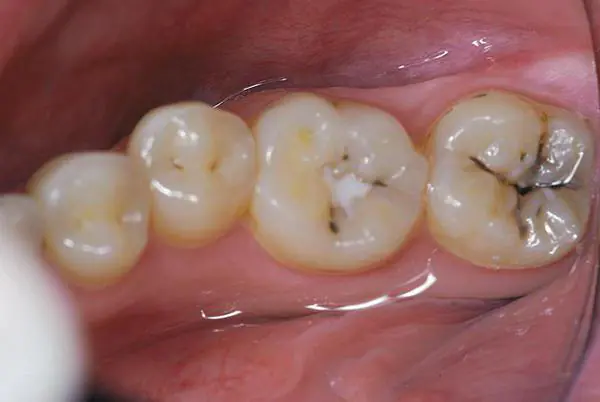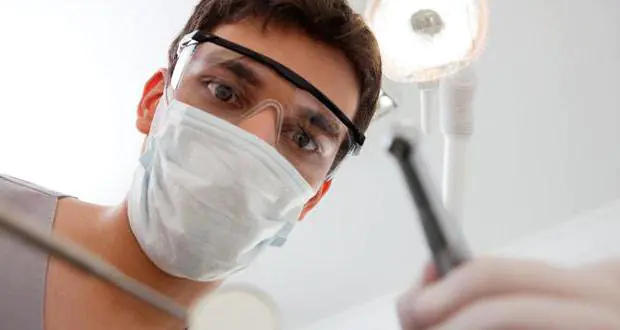For many people, toothache is just pure hell, and they really want to get rid of it as quickly as possible. In this case, the dentist seems to be our only salvation. It will help you say goodbye to this problem once and for all. However, it often happens that patients leave the dentist with almost the same pain. Naturally, such people are very interested in why a tooth hurts after filling.

It is known that we have the most sensitive nerve endings in our mouth, and the process of filling, eliminating infected and dead tissue is an additional injury to which the body responds with a natural reaction.
Filling process
There are actually several reasons for discomfort, and the most obvious of them is the body’s reaction to surgical intervention, as well as improper installation of a filling, incompletely cured caries, or failure to follow doctor’s instructions. If the pain does not stop within 10-12 days after filling, you need to go to the doctor and determine the cause.
Fillings are usually placed to treat caries that destroys the tooth. The filling process is not the most pleasant procedure, but it is the most optimal solution to the problem. The patient is given an anesthetic, then the affected tooth is opened and the damaged tissue is removed. After which the actual filling itself, grinding and the final stage - polishing - takes place.
What kind of pain is there?
In severe, advanced cases, it may be necessary to completely clean out the carious cavity, and sometimes remove the nerve. All work is divided into several stages, and if the dentist makes a mistake in one of them, pain cannot be avoided.
When discomfort occurs:
- when chewing and biting, contact with cold or hot food;
- in a calm state.

- The first is the body’s natural reaction to the installation.
- The second is a doctor’s mistake.
- The third is failure to follow the dentist’s recommendations.
Why does a tooth hurt after filling: reasons
Incorrect diagnosis. Pulpitis can easily be confused with chronic caries, and an inexperienced doctor may make a mistake by placing a filling in the wrong place. Another situation is when depressurization occurs, the material moves away from the bottom of the cavity, thereby irritating the nerve endings and causing severe discomfort to the patient.
Dental polymerizers have a negative effect on the oral cavity and the pulp, changing its structure, and this is another reason why a tooth hurts after filling. The tooth cavity must be prepared before installation, namely, evenly dried. Overdrying leads to irritation of nerve endings, which is why malaise appears. An incorrectly installed filling will interfere and cause pain when bitten.
An allergic reaction to composite materials or medications may occur. In this case, pain appears immediately after filling. Nearby soft tissues swell, gums, jaw and even head hurt greatly.
The doctor's fault
Often, the dentist himself is to blame for the patient’s suffering, who, having decided to save money, used cheap materials or, through negligence, installed the filling incorrectly. Unpleasant pulsation, followed by acute pain, occurs when the dentist hastened to cement the canal and installed a filling on the day of the patient’s first visit.

Why does a tooth hurt after filling? The nerve was not completely removed, but it must be removed radically. If infected nerve tissue remains, pus will collect under the filling and an inflammatory process will develop, which is usually accompanied by an increase in temperature. If not installed correctly, the composite material can extend beyond the tooth root and irritate the soft tissue, causing inflammation.
The exit of the filling material beyond the boundaries of the hard tissues located inside the gum can also cause inflammation. Why does a tooth hurt after filling? This is the body's response to infection.
Reasons for the formation of pathogenic microflora
If you look at the diagram of the tooth structure and root canals, you can see several small conical tubes. But the diagram does not give a complete picture, and the exact number of such branches cannot be seen before treatment begins. It is impossible to properly process and seal all branches.
Therefore, if they remain in their original state after treatment, the inflammation does not go away and persists, causing toothache. Even a highly qualified specialist cannot control the lumen of the canal along its entire length. Here are just a few factors that cause inflammation:
- not completely cleaned infected canal walls;
- the walls of the root canals are poorly washed from blood;
- the appearance of pores when installing a filling;
- resorption of the composite material after installation.
The list of treatment defects that lead to the accumulation of pathogenic microflora does not end there.
When pain is normal
Not every pain can be a signal that you need to immediately run to the dentist. First of all, it is worth determining her character. If the question arises about why a tooth hurts after filling when pressure is applied, this may be due to local irritation of nearby tissues. Often, a doctor, working with metal instruments, damages the gums and root system. In this case, the pain should go away on its own.

When a filling was placed on a tooth that was already bothering you, the discomfort will continue for some time. It is important at this time not to provoke pain by eating hot or cold food or drinks.
Pain may be increased by:
- too sweet food;
- additional load on the tooth;
- eating solid foods;
- hypothermia.
Failure to follow these recommendations often lies the answer to the question of why a child’s tooth hurts after filling. Children need to be monitored very closely during rehabilitation.
First aid
When the pain does not go away within two weeks, this is a clear reason not to delay a second visit to the dentist. It is not always possible to see a doctor right away, and toothache cannot be tolerated. Here two questions arise: “Why does the tooth hurt after filling? What should I do before going to the clinic?”
The first thing you can do is take painkillers. In such cases, drugs based on ibuprofen or paracetamol are recommended. Alcohol tincture of propolis, from which dental lotions are made, will help calm inflammation. It is also used for rinsing the mouth.
- Decoctions of sage, chamomile, celandine, oak bark, acupressure, beets crushed into porridge, and fir oil compresses effectively help eliminate discomfort.
- A proven remedy will help relieve swelling - rinsing the mouth with a soda-saline solution (dissolve 0.5 tablespoons of salt and soda in a glass of warm water).

Swelling and swelling
The gums may become very swollen after filling. In some cases this is a normal phenomenon, in others it is a signal of the onset of a serious infectious process. Redness, swelling, temperature are the first signs that purulent inflammation is developing. If in this case you do not consult a doctor, the situation can be fatal. The fact is that the pus that accumulates in the gums does not go away on its own and does not resolve; it seeks a way out.
Not finding it, the infection spreads through the bloodstream, reaching the maxillary sinuses, and then goes to the brain. Therefore, it is necessary to make a surgical incision in a timely manner and allow the pus to come out.
Choosing a specialist
It is important to trust dental treatment, including fillings, only to specialists who will approach the problem responsibly and reduce the risk of sensations that disturb the patient. Normally, pain goes away after a week, although some doctors allow a longer period, it all depends on the degree of tooth decay.

The effectiveness of treatment is largely determined by the quality of the materials and instruments used, as well as the qualifications of the doctor, that is, compliance with all technologies. Negligent attitude of a specialist can lead to:
- flux and swelling;
- infectious infection;
- reactions to temperature changes;
- loss of filling;
- allergic reaction.
Often people are afraid to go to the dentist not only because of the fear of pain, but also because of the high cost of services. An experienced specialist may provide services at inflated prices, but if he has proven himself well, then it is better to overpay once than to suffer and spend even more money later.
Diagnosis of periodontitis
If caries reappears on a filled tooth, it is necessary to treat the carious cavity with special solutions and insert a new filling. In any case, a repeated examination by a doctor is required, even in the absence of other symptoms.

With periodontitis, pain may occur after filling. The doctor is not to blame in such a situation. No one can guarantee a successful result of periodontitis treatment and will not immediately determine why a tooth hurts after canal filling. With this procedure, the movement of microbes is stopped, but some of them remain sealed under the seal until the body copes with them on its own.
When the first symptoms of caries appear, you should immediately contact a doctor to fill the tooth and close the affected area. It is good if the caries is shallow and the damage affects only the top layer of enamel. For deeper caries, it is necessary to fill the dental canals - this is a traumatic and unpleasant process. Often, discomfort is felt not only at the dentist’s appointment, but also after it. Let's figure out why a tooth hurts after filling and how to eliminate the discomfort.
tooth hurts after filling
When going to the dentist with an acute toothache, the patient hopes to get rid of severe discomfort and pain in the painful area as soon as possible. However, filling does not always bring the expected result - after visiting a doctor, the tooth may continue to hurt. What are the reasons for this phenomenon?
If your tooth hurts a little after a visit to the doctor, do not worry - this may be caused by the body’s natural reaction to dental intervention. Even if the doctor did everything correctly, the tooth hurts after filling the canals, and then aches slightly for up to two weeks.
If the pathology is not completely cured, toothache may also persist. Another visit to the doctor is necessary so that the doctor can repeat the treatment, otherwise pulpitis may develop. If the patient has a chronic inflammatory process at the root of the tooth, then treatment of caries can provoke its exacerbation. Most often, such hidden inflammation is pulpitis, which the doctor could not identify during the preliminary examination of the patient.
Soft tissues damaged by instrumentation can also cause discomfort. If the intervention did not end with one visit and you had to irritate the inflamed area several times, then the toothache after root canal filling will go away for a long time.
Pain also occurs if the technique of installing the filling is violated - if the doctor has over-dried or under-dried the tooth walls, then pain is likely to occur, since the filling fits poorly in problem areas. The quality of the material also affects possible complications. When working with good material, problems almost never arise, but low-quality filling components lead to the filling cracking and not attaching well.
It is very rare, but not impossible, for instruments to break off, after which pieces of probes or other objects have to be removed surgically. Individual sensitivity – you shouldn’t discount it either, because all people have different pain thresholds.
An allergy to the material from which the filling is made can cause discomfort. It is quite rare, since today dentistry uses the most hypoallergenic components possible.
Symptoms of discomfort after filling
Symptoms after filling can be varied - from mild discomfort in the area of manipulation to severe pain, which the doctor recommends to relieve by taking medication.
There are also several characteristic sensations that will help make a diagnosis - why does a tooth hurt after canal filling, and such symptoms appear both separately and in pairs with each other.
Among the most common symptoms, doctors note the following:
- discomfort when pressing on the tooth – this feeling can occur when biting and chewing food;
You should not eat too much sweets or drink carbonated water - this contributes to increased salivation and impaired acidity in the oral cavity, which also negatively affects the filling.
Hats
At first, and always during the cold season, you should not walk without a hat and scarf. Filling a tooth increases the tissue's susceptibility to various negative factors. Therefore, even the slightest hypothermia can cause a tooth to hurt after a filling.
Solid food
It is necessary to temporarily exclude solid foods from the diet. Tooth enamel, although highly durable and resistant to external damage, is still damaged by hard foods. Such damage can also occur to a filling that has not yet completely hardened.
Features of chewing
For the first few days, doctors do not recommend chewing on the side where the filling was performed. It is best to chew food with the healthy side of the jaw, because the pressure can cause the still damp filling to sag downwards. For this reason, the curves of the filling will not completely conform to the tooth, resulting in pressure on the walls of the tooth, and it will hurt.
In addition, frequent mechanical irritation of the tooth where the filling was performed leads to a characteristic counteracting effect, when swelling and irritation after treatment will not decrease, but rather increase.
To give up smoking
An important factor in recovery after filling. The misconception that tobacco smoke soothes toothache still exists today. For the mucous membrane of a damaged tooth, as for all healthy teeth, smoke is poisonous; it poisons the cells of the mucous membrane and negatively affects the filling material.
If you follow all the recommendations listed above, there will be no pain after filling a tooth. Only minor discomfort felt after anesthesia accompanies conscious patients.
When to see a doctor
Many patients are concerned about how long the tooth hurts after filling, and what to do if the discomfort does not go away. It is worth paying attention not to the duration of pain after canal filling, but to its qualitative characteristics. You should contact a doctor in the following cases:
- if the toothache gets worse every day, the nature of the pain changes, pulsation begins in the damaged tooth;
- if an inflammatory process appears against the background of toothache (redness of the mucous membrane in the area of the problematic tooth, the presence of an abscess, etc.).
When you go to the clinic with severe pain, the doctor will find out the reason why the tooth hurts after a filling. If there are no complications, physiotherapeutic procedures may be prescribed - ultrasound therapy, laser therapy, electrophoresis with anesthetics. Such methods are safe, and they will also help to activate blood circulation and metabolic processes in the area of the jaw where the treatment was carried out.
How to get rid of pain at home
If a tooth ache after filling, patients can help themselves, and at home. You can use the simplest recipe for preparing a solution for rinsing the mouth during inflammatory processes: Add a teaspoon of soda to a glass of warm water, salt and a few drops of iodine. A very mild product will help relieve inflammation. It is necessary to rinse your mouth every two hours.
You can also use infusions of medicinal herbs - chamomile, sage, St. John's wort, calendula. A tablespoon of dry raw material is poured into a glass of boiling water and kept under the lid for at least forty minutes, after which the resulting liquid is filtered and used for rinsing. Herbal infusions can be alternated with soda solution.
The tooth will stop aching after one or two times of using rinsing solutions.
If the discomfort does not go away and your teeth hurt after filling, you can use medications. Tablets will help patients Baralgin, Ketorol, Ketanov, Tempalgin, Nimesulide. One tablet is washed down with plenty of water and wait 30-40 minutes; if the pain does not go away, you can take the drug a second time, but not more, since such drugs have a negative effect on the liver.
When pain appears in a tooth, even the most resilient person will not be able to withstand such discomfort for long. The most typical causes of severe pain are carious lesions of varying depths or pulpitis.
Of course, in such situations, the only place of salvation is the dental office. Upon leaving it, many experience long-awaited relief, but sometimes the tooth still hurts after filling. The presence of toothache after a filling procedure leaves no one indifferent, so the patient is puzzled by the question, can a filled tooth ache?
What is filling
During filling, the doctor artificially restores the physiological structure of the affected teeth using filling material and instruments.
The tactics of manipulation will depend on their condition:
- treatment of ordinary caries - in such situations, the doctor installs a filling in the cavity;
- treatment of pulpitis is a more complex procedure that involves filling the tooth canals.
In practice, you can often hear people say that a tooth hurts after canal filling due to nerve removal, or after installing a regular filling. Patients are concerned about what to do if the pain continues, and should there be throbbing pain in the tooth after the filling procedure?
To understand such an exciting topic, you need to have an idea of the treatment process in order to independently distinguish between a normal condition and symptoms of abnormalities. In many cases, after a filling has been placed, teeth hurt for natural reasons and this is not always a sign of pathology.
How long does the pain last?
Many people are interested in how long a tooth hurts after filling. This depends on how extensive the cavity was before treatment and individual susceptibility.
Stages of caries. The larger the cavity, the more difficult the treatment.
The therapeutic algorithm for initial and intermediate caries consists of the following stages:
- the dentist completely eliminates carious lesions that have affected the tissue;
- then the doctor processes the dental walls so that a filling can be installed in the prepared space;
- to create secondary dentin, the bottom of the cavity is lined with a special gasket;
- a filling is installed;
- at the final stage, the dentist grinds the filling, adjusts it to the bite, and forms fissures on the coronal part.
The process becomes more complicated when it comes to advanced forms of caries, which have deeply affected the dental tissues or led to the occurrence of pulpitis.
Under such circumstances, the doctor takes the following actions:
A good filling is beautiful, but it can hide aching pain.
- opens the dental cavity with a drill, providing free access to the root canals;
- removes the neurovascular bundle (pulp);
- prepares the canals for filling - carefully cleans the affected areas with special needle files from dead tissue, expands the lumen, measures the depth of the working area;
- performs antiseptic treatment;
- using filling material, fills voids along the entire length of the canal;
- installs a temporary filling, and after a while a permanent one.
Why does a tooth hurt after root canal filling or after a filling has been placed? These dental procedures are performed under local anesthesia, thanks to which the patient can easily tolerate the painful procedure.
During the procedure, dental tissues are subjected to serious mechanical damage, especially during the treatment of pulpitis. Therefore, it is considered quite acceptable when a person has a temporary or permanent filling, and the tooth aches after the effect of the painkiller wears off.
Do not worry if the unpleasant sensations are present the next day or intensify while eating, biting, closing the jaws, or coming into contact with food or taste irritants.
Got a filling but your tooth hurts? Such symptoms are normal variants and are called post-filling syndrome. The discomfort is temporary and will disappear on its own as soon as the tissues heal.
As a result, we can highlight the main points that indicate a normal pain reaction of a filled tooth to dental trauma. At the same time, it becomes clear how much the tooth hurts after filling:
- the pain is insignificant or has a slight aching character, especially when pressed, and may pulsate;
- every day there is a decrease in discomfort in the tooth, it hurts less and less;
- when treating ordinary caries, it can ache for up to 5 days, but most often the discomfort goes away within 2–3 days;
- It is assumed that after the canal filling is completed, you may feel pain for 1–3 weeks due to greater trauma.
If there is pain under the filling or inflammation of the gums, be sure to go to the doctor.
If the tooth hurts badly, there is intense pulsation, headaches, a sharp increase in temperature, inflammation of the gums, general malaise - this signals the presence of problems, so you cannot tolerate it, but you must again contact the dentist to resolve the situation.
Why does a tooth with a filling hurt?
The most common errors made during the treatment of caries, which cause pain under the filling:
- The dentist treated deep caries due to chronic pulpitis or periodontitis. This is possible if the doctor filled a tooth without studying an x-ray, relying on data from a visual examination of the oral cavity. In this case, the person’s pain pulsates and occurs sporadically, intensifies at night, and worries for a long time. If you have these sensations, it is recommended to consult a dentist without delay, since it is urgent to open the cavity and treat the canals;
- Inflammation develops in the treated tooth due to a poorly treated cavity - this means that the doctor did not thoroughly clean the caries and remnants of lesions remain in the tissues, which causes toothache after filling, and will also lead to recurrence of caries in the future;
- an allergic reaction to the supplied material - in practice, this phenomenon is very rare, since modern fillings are biocompatible with the human body. The suspicion is confirmed if not only the tooth aches, but there is also skin itching, rash, and swelling;
- The installed filling does not correspond to the bite. Sometimes it happens that under the influence of an anesthetic, the patient cannot clearly determine how comfortable he is with the new filling, or is embarrassed to say so. When sensitivity returns, it is discovered that when closing the jaws, the treated tooth interferes, puts pressure on soft tissues, or causes other discomfort. The problem can be easily eliminated - you should have your bite corrected by a doctor;
- hard tissues were overheated, which caused burns and pulp necrosis, and therefore causes severe pain after the filling is installed;
- Shrinkage of the filling has occurred - a phenomenon called polymerization stress. This property is typical for modern light-curing composites, so the dentist’s task is to fill the dental cavity with the required amount so that there is not too much or too little material. Large layers of composite will put pressure on the crown of the tooth, causing severe pain, and the lack of filling after shrinkage leads to the formation of gaps.
Any patient can experience similar pain sensations. There are two common reasons - natural and treatment error.
The video below describes a way to identify the causes of pain that are the result of improper treatment:
Sealed canals and pain
If pain appears after filling the canals, and it is not short-term, then this often indicates a violation of the technological process of treatment:
- improper pre-treatment of the canal was carried out - elements of caries, pulp residues, infections remained in the cavity, the lumen was not expanded enough;
- the dentist incorrectly determined the depth of the canal, so the material ended up outside the root or the canal was not filled along the entire length, which implies the presence of voids;
- Sometimes during the process of cleaning the canals with thin needles, part of the tip may break off and remain unnoticed while in the canal. Of course, such an action is not intentional, but will lead to severe pain and inflammation after filling. A foreign body can be detected using an x-ray;
- perforation - the canal walls were instrumentally damaged during cleaning. Under normal circumstances, the dentist should immediately correct the misunderstanding by applying an adhesive solution to the through hole to prevent material from leaking through it onto the surrounding tissue. If the canals were sealed in the presence of perforation, then acute pain in the causative tooth is inevitable.
What to do in all of these situations? Take an x-ray and definitely see a dentist for re-treatment.
What do we have to do
As a rule, all painful sensations after the installation of a filling are tolerated quite easily, and soon disappear completely. But if a slight aching pain after filling a tooth distracts you from everyday activities, then simple recommendations will help that will speed up the healing process.
So, what to do if the pain does not go away:
- in the first days after the procedure, eat warm food that does not irritate dental tissues;
- refrain from sour, sweet, hard foods;
- do not load the causal area during chewing;
- maintain careful hygiene;
- if a person knows about his excessive sensitivity, then it is advisable to immediately check with the dentist about painkillers - these could be Nise, Ketanov;
- solutions based on soda, salt or herbs - mint, chamomile, sage - have a calming effect.
When dulling pain with medication, it is important not to increase the dosage on your own, because pills can dull the symptoms, masking the true signs of the pathological process.
Now you know how long a tooth can hurt after a filling is installed and whether it should hurt at all after that. If you have any questions, we will be happy to answer them in the comments.
The article was prepared under the editorship of doctors - dental implantation center ICDI ROOTT
">



